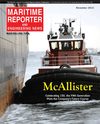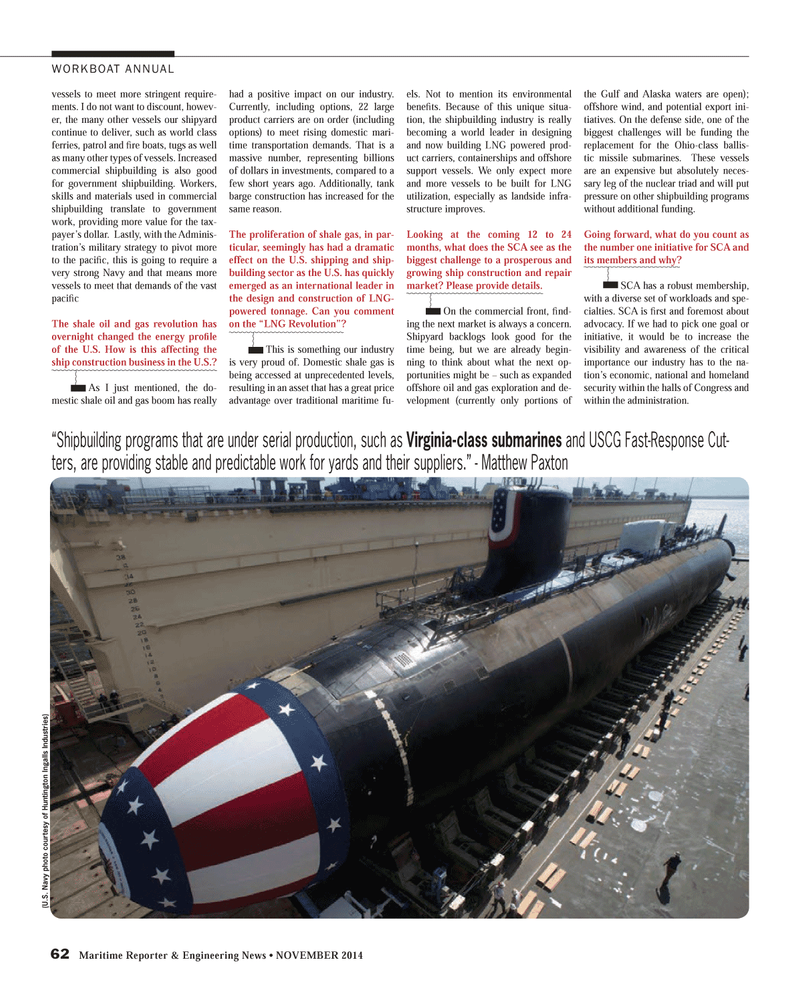
Page 3rd Cover: of Maritime Reporter Magazine (November 2014)
Workboat Edition
Read this page in Pdf, Flash or Html5 edition of November 2014 Maritime Reporter Magazine
62 Maritime Reporter & Engineering News • NOVEMBER 2014
WORKBOAT ANNUAL vessels to meet more stringent require- ments. I do not want to discount, howev- er, the many other vessels our shipyard continue to deliver, such as world class ferries, patrol and ? re boats, tugs as well as many other types of vessels. Increased commercial shipbuilding is also good for government shipbuilding. Workers, skills and materials used in commercial shipbuilding translate to government work, providing more value for the tax- payer’s dollar. Lastly, with the Adminis- tration’s military strategy to pivot more to the paci? c, this is going to require a very strong Navy and that means more vessels to meet that demands of the vast paci? c
The shale oil and gas revolution has overnight changed the energy pro? le of the U.S. How is this affecting the ship construction business in the U.S.? As I just mentioned, the do- mestic shale oil and gas boom has really had a positive impact on our industry.
Currently, including options, 22 large product carriers are on order (including options) to meet rising domestic mari- time transportation demands. That is a massive number, representing billions of dollars in investments, compared to a few short years ago. Additionally, tank barge construction has increased for the same reason.
The proliferation of shale gas, in par- ticular, seemingly has had a dramatic effect on the U.S. shipping and ship- building sector as the U.S. has quickly emerged as an international leader in the design and construction of LNG- powered tonnage. Can you comment on the “LNG Revolution”? This is something our industry is very proud of. Domestic shale gas is being accessed at unprecedented levels, resulting in an asset that has a great price advantage over traditional maritime fu- els. Not to mention its environmental bene?ts. Because of this unique situa- tion, the shipbuilding industry is really becoming a world leader in designing and now building LNG powered prod- uct carriers, containerships and offshore support vessels. We only expect more and more vessels to be built for LNG utilization, especially as landside infra- structure improves.
Looking at the coming 12 to 24 months, what does the SCA see as the biggest challenge to a prosperous and growing ship construction and repair market? Please provide details. On the commercial front, ? nd- ing the next market is always a concern.
Shipyard backlogs look good for the time being, but we are already begin- ning to think about what the next op- portunities might be – such as expanded offshore oil and gas exploration and de- velopment (currently only portions of the Gulf and Alaska waters are open); offshore wind, and potential export ini- tiatives. On the defense side, one of the biggest challenges will be funding the replacement for the Ohio-class ballis- tic missile submarines. These vessels are an expensive but absolutely neces- sary leg of the nuclear triad and will put pressure on other shipbuilding programs without additional funding.
Going forward, what do you count as the number one initiative for SCA and its members and why? SCA has a robust membership, with a diverse set of workloads and spe- cialties. SCA is ? rst and foremost about advocacy. If we had to pick one goal or initiative, it would be to increase the visibility and awareness of the critical importance our industry has to the na- tion’s economic, national and homeland security within the halls of Congress and within the administration. “Shipbuilding programs that are under serial production, such as Virginia-class submarines and USCG Fast-Response Cut- ters, are providing stable and predictable work for yards and their suppliers.” - Matthew Paxton (U.S. Navy photo cour tesy of Huntington Ingalls Industries)
MR #11 (58-65).indd 62 10/30/2014 10:07:44 AM

 61
61

 4th Cover
4th Cover
